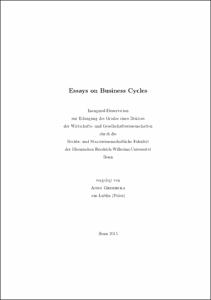Grodecka, Anna: Essays on Business Cycles. - Bonn, 2015. - Dissertation, Rheinische Friedrich-Wilhelms-Universität Bonn.
Online-Ausgabe in bonndoc: https://nbn-resolving.org/urn:nbn:de:hbz:5-40725
Online-Ausgabe in bonndoc: https://nbn-resolving.org/urn:nbn:de:hbz:5-40725
@phdthesis{handle:20.500.11811/6376,
urn: https://nbn-resolving.org/urn:nbn:de:hbz:5-40725,
author = {{Anna Grodecka}},
title = {Essays on Business Cycles},
school = {Rheinische Friedrich-Wilhelms-Universität Bonn},
year = 2015,
month = jul,
note = {The recent Great Recession has renewed interest in the role of financial markets and credit in the economy, as well as in the boundaries of monetary, macroprudential and fiscal policies that impact macroeconomic developments and may influence business cycles. In the first two chapters of this thesis, I devote my attention to the role of credit backed by real estate in the economy.
In the first chapter of the dissertation, I investigate the role of subprime securitization on U.S. business cycles in order to provide a better understanding of secondary financial markets and their impact on macroeconomic variables. I show that due to interbank linkages and banks facing binding capital requirements, the existence of subprime securitization has ambiguous effects on business cycle fluctuations, depending on who is the final buyer of securitized assets. The main contribution of this chapter is the incorporation of some aspects of financial modelling (mortgage backed securities) into an otherwise standard macroeconomic model.
In the second chapter, I study the effects of monetary and macroprudential policies on the economy with a special focus on housing prices in the U.S. and in the U.K. A negative monetary shock leads to a decline in house prices in both countries. The impact of a negative credit shock on house prices remains unclear for U.S. data but is negative for the U.K. Both shocks generally tend to be more powerful in the U.K. than in the U.S., which might be due to the different structure of mortgage contracts in both countries. The main contribution of this chapter is the analysis of the effectiveness of different policy measures aimed at influencing the house price dynamics in an economy in which housing purchases are mainly financed through credit.
The third chapter of this dissertation features a real business cycle model with a climate change externality and addresses the design of optimal environmental instruments. The analysis of the optimal policy instrument to control CO2 emissions under uncertainty arising from business cycles has also gained relevance in the aftermath of the financial and economic crisis of 2008, particularly in the context of reforming the European Union Emissions Trading System (EU ETS). The main contribution of this chapter is extending Weitzman's results to a general equilibrium framework under uncertainty and showing that the main intuition behind the price-quantity argument holds in the “idealized'' world in which the regulator has access to state-contingent environmental instruments.},
url = {https://hdl.handle.net/20.500.11811/6376}
}
urn: https://nbn-resolving.org/urn:nbn:de:hbz:5-40725,
author = {{Anna Grodecka}},
title = {Essays on Business Cycles},
school = {Rheinische Friedrich-Wilhelms-Universität Bonn},
year = 2015,
month = jul,
note = {The recent Great Recession has renewed interest in the role of financial markets and credit in the economy, as well as in the boundaries of monetary, macroprudential and fiscal policies that impact macroeconomic developments and may influence business cycles. In the first two chapters of this thesis, I devote my attention to the role of credit backed by real estate in the economy.
In the first chapter of the dissertation, I investigate the role of subprime securitization on U.S. business cycles in order to provide a better understanding of secondary financial markets and their impact on macroeconomic variables. I show that due to interbank linkages and banks facing binding capital requirements, the existence of subprime securitization has ambiguous effects on business cycle fluctuations, depending on who is the final buyer of securitized assets. The main contribution of this chapter is the incorporation of some aspects of financial modelling (mortgage backed securities) into an otherwise standard macroeconomic model.
In the second chapter, I study the effects of monetary and macroprudential policies on the economy with a special focus on housing prices in the U.S. and in the U.K. A negative monetary shock leads to a decline in house prices in both countries. The impact of a negative credit shock on house prices remains unclear for U.S. data but is negative for the U.K. Both shocks generally tend to be more powerful in the U.K. than in the U.S., which might be due to the different structure of mortgage contracts in both countries. The main contribution of this chapter is the analysis of the effectiveness of different policy measures aimed at influencing the house price dynamics in an economy in which housing purchases are mainly financed through credit.
The third chapter of this dissertation features a real business cycle model with a climate change externality and addresses the design of optimal environmental instruments. The analysis of the optimal policy instrument to control CO2 emissions under uncertainty arising from business cycles has also gained relevance in the aftermath of the financial and economic crisis of 2008, particularly in the context of reforming the European Union Emissions Trading System (EU ETS). The main contribution of this chapter is extending Weitzman's results to a general equilibrium framework under uncertainty and showing that the main intuition behind the price-quantity argument holds in the “idealized'' world in which the regulator has access to state-contingent environmental instruments.},
url = {https://hdl.handle.net/20.500.11811/6376}
}






